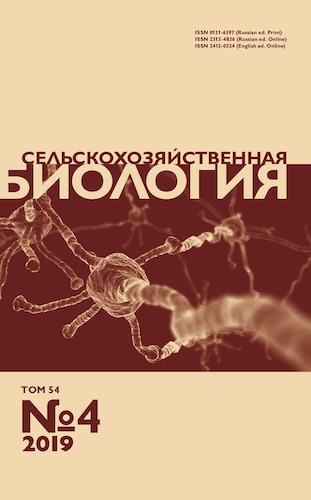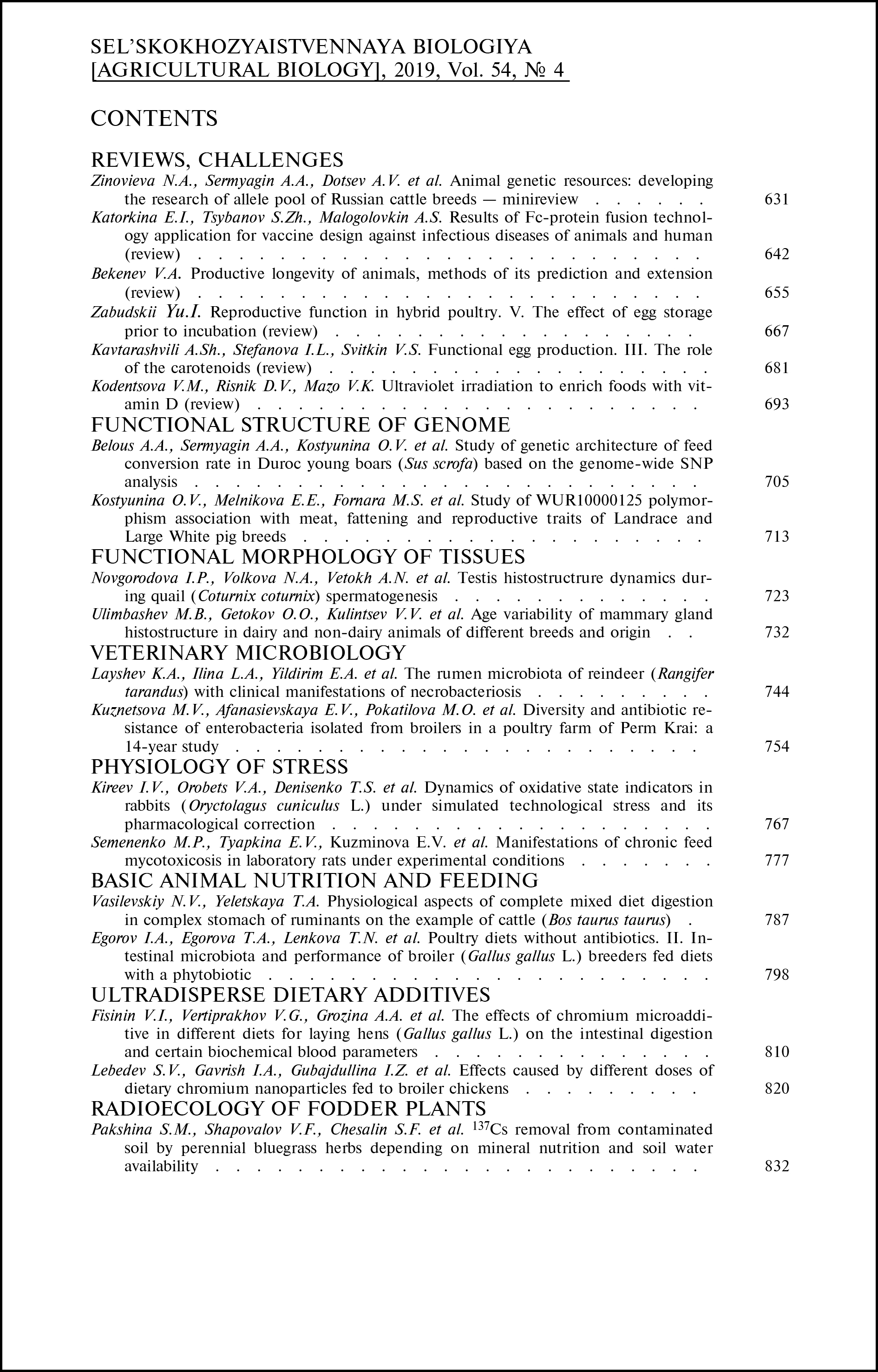doi: 10.15389/agrobiology.2019.4.798eng
UDC: 636.52/.58:636.084.416:579.6
Acknowledgements:
Supported financially by Russian Science Foundation, grant No. 16-16-04089-P, for the study of the physiological and microbiological characteristics of the embryonic and postembryonic digestion in meat chicken to develop feeding programs ensuring complete use of genotype potential”
POULTRY DIETS WITHOUT ANTIBIOTICS. II. INTESTINAL MICROBIOTA AND PERFORMANCE OF BROILER (Gallus gallus L.) BREEDERS FED DIETS WITH A PHYTOBIOTIC
I.A. Egorov1, T.A. Egorova1, T.N. Lenkova1, V.G. Vertiprakhov1,
V.A. Manukyan1, I.N. Nikonov1, A.A. Grozina1, V.A. Filippova2,
E.A. Yildirim2, L.A. Ilyina2, A.V. Dubrovin2, G.Yu. Laptev2
1Federal Scientific Center All-Russian Research and Technological Poultry Institute RAS, 10, ul. Ptitsegradskaya, Sergiev Posad, Moscow Province, 141311 Russia, e-mail Olga@vnitip.ru, eta164@mail.ru, dissovet@vnitip.ru, Vertiprakhov63@mail.ru, manukyan@vnitip.ru, ilnikonov@yandex.ru, alena_fisinina@mail.ru;
2JSC «Biotrof+», 19 korp. 1, Zagrebskii bulv., St. Petersburg, 192284 Russia, e-mail filippova@biotrof.ru, deniz@biotrof.ru, ilina@biotrof.ru (✉ corresponding author), dubrowin.a.v@yandex.ru, georg-laptev@rambler.ru
ORCID:
Egorov I.A. orcid.org/0000-0001-9122-9553
Grozina A.A. orcid.org/0000-0002-3088-0454
Egorova T.A. orcid.org/0000-0002-5102-2248
Filippova V.A. orcid.org/0000-0001-8789-9837
Lenkova T.N. orcid.org/0000-0001-8026-3983
Yildirim E.A. orcid.org/0000-0002-5846-4844
Vertiprakhov V.G. orcid.org/0000-0002-3240-7636
Ilina L.A. orcid.org/0000-0003-2490-6942
Manukyan V.A. orcid.org/0000-0003-4564-4427
Dubrovin A.V. orcid.org/0000-0001-8424-4114
Nikonov I.N. orcid.org/0000-0001-9495-0178
Laptev G.Yu. orcid.org/0000-0002-8795-6659
Received April 30, 2019
The worldwide experience is explicitly evidencing that genetically conditioned productivity potential in poultry can be realized only in healthy birds. Since the implementation of the antibiotic bans in EC countries a constant search for the effective alternatives to in-feed antibiotic growth promoters (AGP) is still in progress. The additives of different types (probiotics, prebiotics, synbiotics, symbiotics, acidifiers, phytobiotics) with growth-stimulating efficiency close to that in antibiotics and inducing no harmful effects become increasingly popular in practical poultry nutrition. The efficiency of phytobiotic Intebio based on the essential oils in diets for growing chicken of preparental lines B5 and B9 (selected by Smena Center for Genetic Selection) was studied. The parameters of growth efficiency, duodenal and circulatory activity of the digestive enzymes in fistulated birds, the results of molecular genetic analysis of the composition of duodenal and cecal microbiota are presented. It was found that live bodyweight in males and females in both lines at 21 weeks of age was similar in control treatments fed diets supplemented with AGP and experimental treatments fed diets supplemented with Intebio (3172 g in males and 2318 in females vs. 3169 and 2316 g, respectively, in control in B5 line; 2590 and 1917 g vs. 2589 and 1920 g in males and females, respectively, in B9 line). Reproductive organs (testicles in males and ovaries and oviducts in females) were normally developed in all lines and treatments. Supplementation of diets with the phytobiotic significantly increased lipase activity in the duodenal digesta in B5 line (by 30.9 %, р ≤ 0.05) and B9 line (by 98.3 %, р ≤ 0.01), and protease activity in B5 line (by 36.4 %, р ≤ 0.05). The activity of lipase in B9 line was significantly (р ≤ 0.001) lower in compare to B5 line in the duodenal digesta (by 59.9 %) and in blood serum (by 48.3 %). Digestibility of dietary dry matter in males and females of B5 line was higher by 3.11 % in compare to B9 line, digestibility of fat higher by 2.95 %, nitrogen retention higher by 2.12 %. The taxonomic composition of duodenal microbiota in both lines is found to be affected by the dietary phytobiotic. In phytobiotic-treated birds the significant increases were found in the duodenal populations of certain polysaccharide-fermenting species (phylum Bacteroides, class Clostridiales) and species with high antagonistic activity against avian pathogens (Bifidobacterium spp., Bacillus spp.).
Keywords: growing chicken, preparental lines, live bodyweight, digestive enzymes, phytobiotic, intestinal microbiota.
REFERENCES
- Fisinin V.I., Egorov I.A., Laptev G.Yu., Lenkova T.N., Nikonov I.N., Il'ina L.A., Manukyan V.A., Grozina A.A., Egorova T.A., Novikova N.I., Iyldyrym E.A. Voprosy pitaniya, 2017, 86(6): 114-124 CrossRef
- Konstantinov V. Kombikorma, 2010, 6: 115-116 (in Russ.).
- Smith J.A. The future of poultry production in the USA without antibiotics. Poultry International, 2002, 41: 68-69.
- Fisinin V.I., Okolelova T.M., Prosviryakova O.A., Andrianova E.N., Kryukov O.V., Kuzovnikova A., Narmontiene M., Bevzyuk V.N., Papazyan T.T., Tardat'yan A.G., Shchukina S.A., Kosintsev Yu.V., Timofeva E.N. Organicheskie kisloty i podkisliteli v kombikormakh dlya ptitsy [Organic acids and acidifiers in poultry feed]. Sergiev-Posad, 2008 (in Russ.).
- Dzhavadov E.D., Dmitrieva M.E., Trefilov B.B, Novikova O.B., Titova T.G. Veterinariya i kormlenie, 2016, 2: 24-27 (in Russ.).
- Collier C.T., Hofacre C.L., Payne A.M., Anderson D.B., Kaiser P., Mackie R.I., Gaskins H.R. Coccidia induced mucogenesis promotes the onset of necrotic enteritis by supporting Clostridium perfringens growth. Veterinary Immunology and Immunopathology, 2008, 122(1-2): 104-115 CrossRef
- Hermans D., Pasmans F., Messens W., Martel A., Van Immerseel F., Rasschaert G., Heyndrickx M., Van Deun K., Haesebrouck F. Poultry as a host for the zoonotic pathogen Campylobacter jejuni. Vector-Borne and Zoonotic Disease, 2012, 12(2): 89-98 CrossRef
- Seys S.A., Sampedro F., Hedberg C.W. Assessment of meat and poultry product recalls due to Salmonella contamination: product recovery and illness prevention. Journal of Food Protection, 2017, 80(8): 1288-1292 CrossRef
- Hashemi S.R., Zukifli I., Hair Bejo M., Farida A., Somchit M.N. Acute toxicity study and phytochemical screening of selected herbal aqueous extract in broiler chickens. International Journal of Pharmacology, 2008, 4(5): 352-360 CrossRef
- Kryukov V.S., Glebova I.V. Problemy biologii produktivnykh zhivotnykh, 2017, 3: 5-25 (in Russ.).
- Nazzaro F., Frantianni F., De Marino L., Coppala R., De Feo V. Effect of essential oils on pathogenic bacteria. Pharmaceuticals, 2013, 6(12): 1451-1474 CrossRef
- Christaki E., Bonos E., Giannenas I., Florou-Paneri P. Aromatic plants as a source of bioactive comppouds. Agriculture, 2012, 2(3): 228-243 CrossRef
- Zeng Z., Zhang S., Wang H., Piao X. Essential oil and aromatic plants as feed additives in non-ruminant nutrition: a review. Journal of Animal Science and Biotechnology, 2015, 6(1): Article 7 CrossRef
- Odoemalam V.U., Etuk I.F., Ndelekwute E.K., Iwuji T.C., Ekwe Ch.C. Herbs and spices: option for sustainable animal production. Journal of Biology, Agriculture and Healthcare, 2013, 3(7): 116-124.
- Costa L.B., Luciano F.B., Miyada V.S., Gois F.D. Herbal extracts and organic acids as natural feed additives in pig diets. South African Journal of Animal Science, 2013, 43(2): 181-193 CrossRef
- Egorova A.V. Ptitsevodstvo, 2012, 12: 8-10 (in Russ.).
- Egorova A.V., Tuchemskii L.I., Emanuilova Zh.V. Zootekhniya, 2015, 6: 2-4 (in Russ.).
- Yeoman C.J., Chia N., Jeraldo P., Sipos M., Goldenfeld N.D., White B.A. The microbiome of the chicken gastrointestinal tract. Animal Health Research Reviews, 2012, 13(1): 89-99 CrossRef
- Kerr A.K., Farrar A.M., Waddell L.A., Wilkins W., Wilhelm B.J., Bucher O., Wills R.W., Bailey R.H., Varga C., McEwe S.A., Rajić A. A systematic review-meta-analysis and meta-regression on the effect of selected competitive exclusion products on Salmonella spp. prevalence and concentration in broiler chickens. Preventive Veterinary Medicine, 2013, 111(1-2): 112-125 CrossRef
- Dobson A., Cotter P.D., Ross R.P., Hill C. Bacteriocin production: a probiotic trait? Applied and Environmental Microbiology, 2012, 78(1): 1-6 CrossRef
- Messaoudi S., Kergourlay G., Dalgalarrondo M., Choiset Y., Ferchichi M., Prévost H., Pilet M.F., Chobert J.M., Manai M., Dousset X. Purification and characterization of a new bacteriocin active against Campylobacter produced by Lactobacillus salivarius SMXD51. Food Microbiology, 2012, 32(1): 129-134 CrossRef
- Sekirov I., Russell S.L., Antunes L.C.M., Finlay B.B. Gut microbiota in health and disease. Physiol. Rev., 2010, 90(3): 859-904 CrossRef
- Sun H., Tang J.W., Fang C.L., Yao X.H., Wu Y.F., Wang X., Feng J. Molecular analysis of intestinal bacterial microbiota of broiler chickens fed diets containing fermented cottonseed meal. Poultry Science, 2013, 92(2): 392-401 CrossRef
- Wei S., Morrison M., Yu Z. Bacterial census of poultry intestinal microbiome. Poultry Science, 2013, 92(3): 671-683 CrossRef
- Stanley D., Geier M.S., Chen H., Hughes R.J., Moore R.J. Comparison of fecal and cecal microbiotas reveals qualitative similarities but quantitative differences. BMC Microbiology, 2015, 15(1): Article 51 CrossRef
- LeBlanc J.G., Milani C., de Giori G.S., Sesma F., van Sinderen D., Ventura M. Bacteria as vitamin suppliers to their host: a gut microbiota perspective. Curr. Opin. Biotechnol., 2013, 24(2): 160-168 CrossRef
- Fasina Y.O., Hoerr F.J., McKee S.R., Conner D.E. Influence of Salmonella enterica serovar Typhimurium infection on intestinal goblet cells and villous morphology in broiler chicks. Avian Diseases, 2010, 54(2): 841-847 CrossRef
- Chae B., Ingale S., Kim J., Kim K., Sen S., Lee S., Khong C., Kim E.K., Kwon I.K. Effect of dietary supplementation of probiotics on performance, caecal microbiology and small intestinal morphology of broiler chickens. Animal Nutrition and Feed Technology, 2012, 12(1): 1-12.
- Liao N., Yin Y., Sun G., Xiang C., Liu D., Yu H.D., Wang X. Colonization and distribution of segmented filamentous bacteria (SFB) in chicken gastrointestinal tract and their relationship with host immunity. FEMS Microbiology Ecology, 2012, 81(2): 395-406 CrossRef
- Sekelja M., Rud I., Knutsen S.H., Denstadli V., Westereng B., Naes T., Rudi K. Abrupt temporal fluctuations in the chicken fecal microbiota are explained by its gastrointestinal origin. Applied and Environmental Microbiology, 2012, 78(8): 2941-2948 CrossRef
- Merina-Gluzkina V.M. Laboratornoe delo, 1965, 3: 142-146 (in Russ.).
- Batoev Ts.Zh. Sbornik nauchnikh trudov Buryatskogo SKHI (Ulan-Ude), 1971, 25: 122-126 (in Russ.).
- Instruktsii po sanitarno-mikrobiologicheskomu kontrolyu tushek, myasa ptitsy, ptitseproduktov, yaits i yaitseproduktov na ptitsevodcheskikh i pererabatyvayushchikh predpriyatiyakh [Instructions for sanitary and microbiological inspection of poultry carcasses, meat and products, eggs and egg products in poultry farming and during processing]. Moscow, 1990 (in Russ.).
- Wilson K., Walker J. Printsipy i metody biokhimii i molekulyarnoi biologii [Principles and techniques of biochemistry and molecular biology]. Moscow, 2015 (in Russ.).
- Mikhailova A.G., Khairullin R.F., Demidyuk I.V., Kostrov S.V., Grinberg N.V., Burova T.V., Grinberg V.Y., Rumsh L.D. Cloning, sequencing, expression, and characterization of thermostability of oligopeptidase B from Serratia proteamaculans, a novel psychrophilic protease. Protein Expression and Purification, 2014, 93: 63-76 CrossRef
- Egorov I.A., Manukyan V.A., Lenkova T.N., Okolelova T.M., Lukashenko V.S., Shevyako A.N., Ignatova G.V., Egorova T.V., Andrianova E.N., Rozanov B.L., Lysenko M.A., Egorova T.A., Grozina A.A., Laptev G.Yu., Nikonov I.N., Aleksandrova I.L., Il'ina L.A., Novikova N.I., Fisinin V.I. Metodika provedeniya nauchnykh i proizvodstvennykh issledovanii po kormleniyu sel'skokhozyaistvennoi ptitsy. Molekulyarno-geneticheskie metody opredeleniya mikroflory kishechnika [Methodology of laboratory and farm tests on poultry feeding. Molecular methods of intestinal microflora analysis]. Sergiev Posad, 2013 (in Russ.).
- Torok V.A., Hughes R.J., Mikkelsen L.L., Perez-Maldonado R., Balding K., MacAlpine R., Percy N.J., Ophel-Keller K. Identification and characterization of potential performance-related gut microbiota in broiler chickens across various feeding trials. Applied and Environmental Microbiology, 2011, 77(17): 5868-5878 CrossRef
- Diaz-Sanchez S., Hanning I., Pendleton S., D’Souza D. Next-generation sequencing: the future of molecular genetics in poultry production and food safety. Poultry Science, 2013, 92(2): 562-572 CrossRef
- Choi J.H., Kim G.B., Cha C.J. Spatial heterogeneity and stability of bacterial community in the gastrointestinal tracts of broiler chickens. Poultry Science, 2014, 93(8): 1942-1950 CrossRef
- Bjerrum L., Engberg R.M., Leser T.D., Jensen B.B., Finster K., Pedersen K. Microbial community composition of the ileum and cecum of broiler chickens as revealed by molecular and cellular-based techniques. Poultry Science, 2006, 85(7): 1151-1164 CrossRef
- Louis P., Young P., Holtrop G., Flint H.J. Diversity of human colonic butyrate-producing bacteria revealed by analysis of the butyryl-CoA:acetate CoA-transferase gene. Environmental Microbiology, 2010, 12(2): 304-314 CrossRef
- Le Blay G., Blottiere H.M., Ferrier L., Le Foli E.C., Bonnet J.P., Galmiche C., Cherbut C. Short-chain fatty acids induce cytoskeletal and extracellular protein modifications associated with modulation of proliferation on primary culture of rat intestinal smooth muscle cells. Dig. Dis. Sci., 2000, 45(8): 1623-1630 CrossRef
- Fukunaga T., Sasaki M., Araki Y., Okamoto T., Yasuoka T., Tsujikawa T., Fujiyama Y., Bamba T. Effects of the soluble fibre pectin on intestinal cell proliferation, fecal short chain fatty acid production and microbial population. Digestion, 2003, 67(1-2): 42-49 CrossRef
- Niba A.T., Beal J.D., Kudi A.C., Brooks P.H. Bacterial fermentation in the gastrointestinal tract of non-ruminants: influence of fermented feeds and fermentable carbohydrates. Tropical Animal Health and Production, 2009, 41(7): 1393-1407 CrossRef












